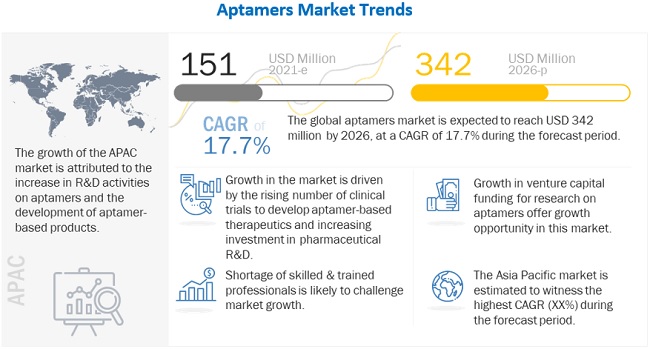Introduction to the Aptamers
Aptamers are single-stranded oligonucleotide molecules that are able to bind to a specific target molecule with high affinity and specificity. They are used to detect and manipulate biological molecules, such as proteins, enzymes, small molecules or even whole cells. Aptamers are generated using a process known as Systematic Evolution of Ligands by Exponential Enrichment (SELEX), which involves in vitro selection of a large pool of random oligonucleotide sequences. The selected sequences are able to bind to the target molecule of interest with high affinity and specificity. Aptamers have been used for a wide range of applications, including drug delivery, diagnostics, and therapeutics.

Market Size and Growth of the Aptamers
aptamers market is projected to reach USD 342 million by 2026, at a CAGR of 17.7% during the forecast period. Growth of aptamers market is attributed to factors such as increase in number of clinical trials for development of aptamer-based therapeutics, increase in awareness about advantages of aptamers as compared to antibodies, rising investment in pharmaceutical RD, and rising prevalence of chronic and rare diseases to increase the demand for aptamer-based therapeutics and diagnostics. Growth in the venture capital funding for research on aptamers and growing collaborations with research institutes and pharmaceutical companies are also expected to offer a wide range of growth opportunities to players in the market. On the other hand, low market acceptance as compared to antibodies is likely to restrain the market growth while shortage of skilled trained professionals may challenge market growth to a certain extent.
Types of Aptamers and Their Applications
Aptamers are single-stranded nucleic acid molecules that bind to a specific target molecule with a high affinity and selectivity. They can be generated from a variety of sources, including DNA, RNA, and peptides. Aptamers can be used for a variety of applications, including diagnostics, therapeutics, and drug delivery.
The three main types of aptamers are DNA aptamers, RNA aptamers, and peptide aptamers.
DNA aptamers are generated from a pool of random sequences and can bind to targets via hydrogen bonding and electrostatic interactions. They are used in diagnostics and therapeutics, such as detecting and treating cancer or infectious diseases.
RNA aptamers are generated from a pool of random sequences and can bind to targets via hydrogen bonding and electrostatic interactions. They are used in diagnostics, therapeutics, and drug delivery, such as detecting and delivering target molecules to specific cells.
Peptide aptamers are generated from a pool of random sequences and can bind to targets via hydrogen bonding, electrostatic interactions, and hydrophobic interactions. They are used in diagnostics, therapeutics, and drug delivery, such as detecting and delivering target molecules to specific cells.
Major Players in the Aptamers Market:
Aptamer Group (UK), Raptamer Discovery Group (US), SomaLogic Inc., (US), Aptamer Sciences, Inc. (South Korea), Aptagen, LLC (US), Maravai Lifesciences (US), Kaneka Corporation (Japan), NeoVentures Biotechnology Inc. (Canada), Aptus Biotech (Spain), Base Pair Biotechnologies (US), AMSBIO (UK), Novaptech (France), Bio-Techne (US)
Trends in the Aptamers
There have been several trends in the development of aptamers over the years. One trend is the increasing use of aptamers for therapeutic and diagnostic applications. Aptamers are being used to target and bind to specific proteins or cellular components, allowing for the detection and treatment of diseases. This has led to the development of aptamer-based therapeutics, diagnostics, and imaging agents.
Another trend is the increasing use of aptamers in combination with other technologies, such as nanotechnology and gene editing. This has enabled the development of novel therapeutic and diagnostic strategies, such as targeted gene therapy and targeted drug delivery.
Finally, there has been a trend towards the development of more sophisticated aptamers. Advances in molecular biology and biochemistry have enabled the development of aptamers that are more specific, with higher affinity and selectivity for their target molecules. This has led to the development of aptamer-based therapies that are more effective and less toxic.
Challenges Facing the Aptamers
- Efficiency: Aptamers are relatively new and are still in the early stages of development. As a result, they are not as efficient as traditional antibodies. This is because aptamers are not as specific or as sensitive as antibodies and they require more optimization to reach their full potential.
- Cost: Aptamers are more expensive than traditional antibodies, due to the complexity of the production process.
- Stability: Aptamers are less stable than antibodies and can be easily degraded by heat, pH, and other environmental factors.
- Flexibility: Aptamers are not as flexible as antibodies, which limits their ability to bind to different targets.
- Availability: Aptamers are not as readily available as antibodies, due to the complexity of the production process.
Conclusion
Aptamers are a promising class of molecules that have demonstrated potential in a variety of applications. They offer a powerful alternative to antibodies and other molecules in terms of their specificity, affinity, and cost-effectiveness. Aptamers are also highly customizable and can be tailored to target specific molecules and biological pathways. While much progress has been made in the field of aptamer development, there is still much work to be done to further improve their design and efficacy. Additionally, further research is needed to gain a better understanding of their structure-function relationships and to develop better strategies for their delivery and use in vivo. With continued advances in the field, aptamers have the potential to revolutionize biomedical research and drug development.
Frequently Asked Questions (FAQ):
- Which type of products is leading the by type segment?
- Which is the leading end user for aptamers market?
- Which is the leading technology in aptamers market?
- Who are the key players operating in the aptamers market?
- Which geographical region is dominating in aptamers market?
Content Source:
https://www.marketsandmarkets.com/Market-Reports/aptamers-technology-market-1167.html
https://www.marketsandmarkets.com/PressReleases/aptamers-technology.asp


![Splunk SPLK-3002 PDF Questions – [April-2022] SPLK-3002 Braindumps](https://thewion.com/upload/photos/2022/04/LZZD6wI8vPTij45DmLus_11_6ccce81b98c50e50025472bef3dfc83a_image.jpeg)
